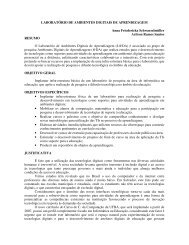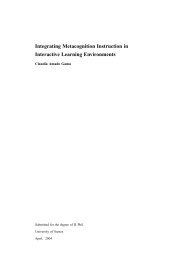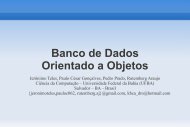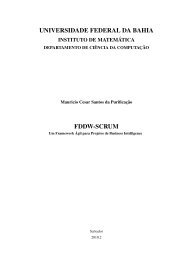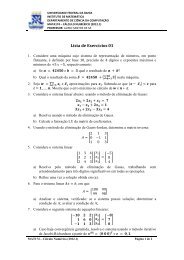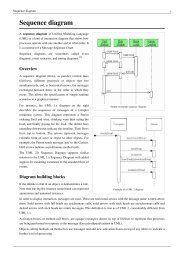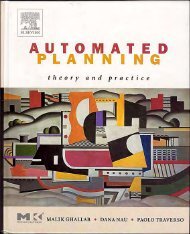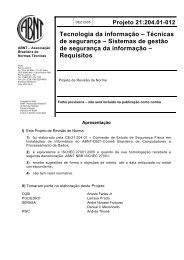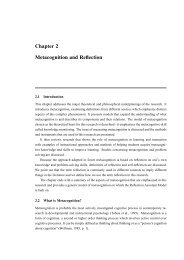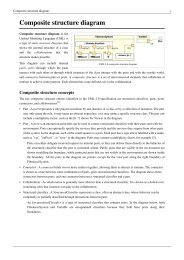Chapter 5 The Domain in MIRA: Algebra Word Problems
Chapter 5 The Domain in MIRA: Algebra Word Problems
Chapter 5 The Domain in MIRA: Algebra Word Problems
You also want an ePaper? Increase the reach of your titles
YUMPU automatically turns print PDFs into web optimized ePapers that Google loves.
<strong>Chapter</strong> 5. <strong>The</strong> <strong>Doma<strong>in</strong></strong> <strong>in</strong> <strong>MIRA</strong>: <strong>Algebra</strong> <strong>Word</strong> <strong>Problems</strong> 902. Read the problem description and identify the givens of the problem. Create a variable foreach given and assign the known value to this variable.3. Identify the unknowns that are explicitly described <strong>in</strong> the problem statement and def<strong>in</strong>evariables to represent them.4. Select from the problem description the sentences that def<strong>in</strong>e relationships between two ormore elements.5. Rewrite each relation substitut<strong>in</strong>g the parts of the sentence that refer to the components bytheir variables names. If no previously identified component matches any of the components<strong>in</strong> the relation, identify its type (givens, goals, or unknowns) and create an appropriatevariable for it.6. Analyse the mathematical mean<strong>in</strong>g of the relation and decide which arithmetic operatorsshould be applied (+, -, * , /, =).7. Translate the relation <strong>in</strong>to an equation, us<strong>in</strong>g the variables and the operators organized <strong>in</strong>the form that best matches the mean<strong>in</strong>g of the orig<strong>in</strong>al sentence.8. Read each equation produced (<strong>in</strong> more than one way if possible) to verify that it translatesback to the orig<strong>in</strong>al sentence.9. Check carefully if any equation has been omitted and if all variables previously identifiedhave been used <strong>in</strong> the equations.5.6 Design<strong>in</strong>g a Tool to Support <strong>Word</strong> <strong>Problems</strong> TranslationIn order to enable students to use the heuristic proposed, we have designed a tool to support thetranslation of word problems <strong>in</strong>to equations. As expla<strong>in</strong>ed <strong>in</strong> the previous sections, one of thehardest problems <strong>in</strong> translat<strong>in</strong>g algebra problems <strong>in</strong>to equations is comprehend<strong>in</strong>g the situationand construct<strong>in</strong>g representations of it. We would like to develop an <strong>in</strong>structional approach thatgives students control over their process while help<strong>in</strong>g them to build this representation.<strong>The</strong> PAL Tool was designed to meet this requirement. It is the tool <strong>in</strong> <strong>MIRA</strong> that helps studentsto organize and represent the problem <strong>in</strong>to its smaller components (the givens, the goals,the unknowns and relations). <strong>The</strong> PAL Tool implements a specific strategy for translat<strong>in</strong>g algebraword problems. This strategy is <strong>in</strong> l<strong>in</strong>e with strategies proposed by Polya (1945), Mayer (1999)and many algebra courses (e.g. the Math Forum 2 ). It motivates the students to look for specificelements <strong>in</strong> an algebra problem, labell<strong>in</strong>g these elements as givens, goals, and unknowns. Also, ithelps <strong>in</strong> mak<strong>in</strong>g the connections between the relations and the elements previously identified. Itprovides an <strong>in</strong>terface for describ<strong>in</strong>g the components of the problem, creat<strong>in</strong>g variable names, identify<strong>in</strong>gthe relations and the components that are <strong>in</strong>volved <strong>in</strong> each relation. It focuses exclusivelyon the translation stage of algebra problem solv<strong>in</strong>g and is <strong>in</strong>tended to provide limited help on thetask, lett<strong>in</strong>g students figure out the equations on their own.5.6.1 Requirements of the PAL Tool<strong>The</strong> conditions or requirements the PAL tool had to meet <strong>in</strong> its design to achieve the goals were:1. Help students to isolate and categorize parts of the problem;2 <strong>The</strong> Math Forum is an Internet web site for mathematics. http://mathforum.org/



